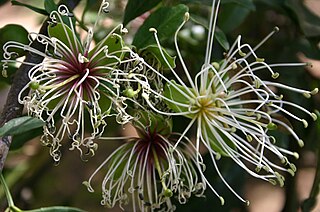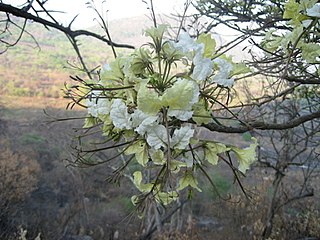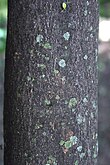
Campanula is the type genus of the Campanulaceae family of flowering plants. Campanula are commonly known as bellflowers and take both their common and scientific names from the bell-shaped flowers—campanula is Latin for "little bell".
Androstachys johnsonii, the Lebombo ironwood, is a medium-sized Afrotropical tree species, and the sole member of the genus Androstachys in the Picrodendraceae. It is slow-growing, evergreen to deciduous, and dioecious, with flowers that are wind-pollinated. It is native to southeastern Africa and Madagascar, where it generally occurs gregariously on rocky hillsides, particularly in hot and dry situations. It produces a hard, durable wood which is of economic interest. Its specific name commemorates W. H. Johnson, a 19th-century Director of Agriculture in Mozambique. Four related species which are native to Madagascar, are usually placed in genus Stachyandra.

The Cleomaceae are a small family of flowering plants in the order Brassicales, comprising about 220 species in two genera, Cleome and Cleomella. These genera were previously included in the family Capparaceae, but were raised to a distinct family when DNA evidence suggested the genera included in it are more closely related to the Brassicaceae than they are to the Capparaceae. The APG II system allows for Cleomaceae to be included in Brassicaceae. Cleomaceae includes C3, C3–C4, and C4 photosynthesis species.

Cadaba is a genus of shrubs in family Capparaceae, with about 30 species. These have simple, alternately set leaves. The zygomorphic flowers, are solitary or stand in small clusters at the end of short side branches. These flowers consist of four sepals, none or four petals with a narrow claw at base and a wider plate at the top, a tube-shaped nectar producing appendix, four or five stamens that are merged for about half their length into a so-called androgynophore, and a gynophore on top of which will develop a cylindrical capsule with one or two cavities that contain many small kindney-shaped seeds, and opens with two valves. The genus name Cadaba is derived from the Arab word "kadhab", a local name for Cadaba rotundifolia. Some species are classified as famine food in southern Ethiopia.

Maerua is a genus of flowering plants in the family Capparaceae. It includes 70 species of shrubs and small trees with its centre of diversity in Africa, though some species extend their range as far north as the Levant, and as far east as the Indian subcontinent and mainland Southeast Asia.

Colotis antevippe, the red tip, is a butterfly of the family Pieridae. It is found in the Afrotropical realm.

Pinacopteryx is a monotypic genus of pierid butterflies found in Africa containing Pinacopteryx eriphia, the zebra white.

Belenois zochalia, the forest white or forest caper white, is a butterfly of the family Pieridae. It is found in Africa.

Capparis tomentosa, the woolly caper bush or African caper, is a plant in the family Capparaceae and is native to Africa.

Capparis fascicularis, the zigzag caper-bush, is a plant in the Capparaceae family and is native to Africa.

Crateva kirkii, commonly known as the three-finger bush, is a small deciduous tree belonging to the Capparaceae or caper family. It ranges through eastern and southern Africa, including Kenya, Tanzania, Democratic Republic of the Congo, Malawi, Mozambique, Zambia, Zimbabwe, Eswatini, and KwaZulu-Natal province of South Africa.

Psychotria capensis, the bird-berry, is a southern African evergreen shrub or small tree. It belongs to a genus which is used medicinally in many regions, 'Psychotria' being from the Greek for 'rejuvenating', in reference to the healing properties of certain species. Kew lists some 2,000 species of Psychotria growing throughout the warmer regions of both hemispheres, but only two of them occur in southern Africa, namely P. capensis and P. zombamontana.

Maerua angolensis is a 10m tall, occasionally deciduous tree of the Capparaceae or caper family, often growing on termitaria and in thickets fringing seasonal watercourses, up to 1800m. Though never common, it is widespread in tropical Africa and arid regions, being absent from high-rainfall regions.

Pterocelastrus echinatus is a small Southern African tree occurring in South Africa, Mozambique, Zimbabwe, Eswatini, and Malawi. This species is found in montane and submontane evergreen forests, forest margins, rocky hillsides, and kloofs, growing between 600 and 2400 m above sea level.

Maerua racemulosa is a species of plant in the Capparaceae family, which is almost endemic to South Africa's coastal regions, where it is a constituent of shady forest understory and valley bushveld. They are shrubs or small trees, with mostly simple leaves, and entire margins. They flower profusely in mid-winter. Each flower bears numerous white filaments and a purple style, but no petals. The round fruit appear from August to October. These are yellow when ripe and 1 cm in diameter. It is a food plant for some species of Colotis butterfly.

Cadaba aphylla ("Swartstorm") is one of the many species in the genus Cadaba. It is indigenous to southern Africa.

Boscia foetida, commonly known as the stink shepherd's tree and the smelly shepherd's bush, is an evergreen shrub or tree that is native to the warmer and drier parts southern Africa. It is found in semi-desert and arid bushveld, and in the west it occurs commonly in areas which are otherwise sparsely wooded. It is known for the particularly unpleasant smell of its flowers which appear during early spring, to which its specific name foetida alludes. Its freshly cut wood likewise has an unpleasant smell, and has traditional medicinal and magical uses, for instance as a protection against lightning. In central Botswana the village of Mopipi is named after this species.

Cadaba farinosa is a 2–8 m (6.6–26.2 ft) high evergreen shrub or small tree that belongs to the caper family. It has simple ovate leaves with entire margins, zygomorphic, spidery, greenish, yellowish, whitish or pinkish flowers, and is covered in powdery hairs or scales, particularly the younger parts. It can be found in a zone from Senegal to India between the desert and the savanna.

Polanisia erosa is a sticky, 10–60 cm (3.9–23.6 in) high annual herbaceous species of flowering plant in the Cleome family, Cleomaceae, known by the common name large clammyweed. It has narrow clover-like leaves, and cream-coloured, frilly flowers with a yellowish centre, looking a bit like a small butterfly or a set of elk antlers. It naturally occurs in dry and sandy habitats in Texas and adjacent parts of Arkansas, Louisiana and Oklahoma.























